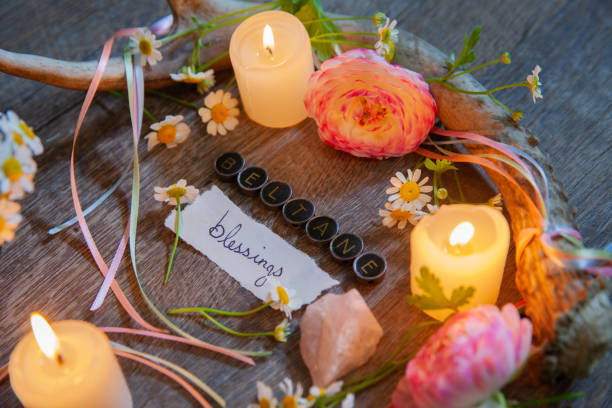Beltane is a fire festival. The word ‘Beltane’ originates from the Celtic God ‘Bel,’ meaning ‘the bright one,’ and the Gaelic word ‘teine,’ meaning fire. Spring has reached its peak, and summer is now on its way.
Who is Bel?
Belenus, or Bel, was a very popular Celtic god. Despite this, not a lot is known about him except that a fire festival was held in his name. His name may mean bright one.
Beltane Traditions.
Fire cleansing: Druids lit bonfires. People jumped over these huge fires to cleanse themselves of negativity and to bring good luck for the rest of the year. I would not advise doing this for obvious reasons!
Cattle were also walked between fires before they were put out to pasture. It was believed that this helped protect them from predators and disease.

Flower and foliage collection: at midnight, the day before May 1st. People would go to the woods and fields to gather flowers and foliage. They would then decorate the homes. Also, flower garlands were made to wear.
Maypole dancing. A large tree was cut down and used as a pole. People would decorate the pole with flowers and ribbons and dance around it. The Maypole represented fertility, marriage prospects, and luck.
Handfastings: Handfastings are a traditional betrothal for a year and a day, after which the couple would either choose to stay together or part without recrimination. The main tradition of handfasting consisted of tying the couple’s hands together, hence the phrase tying the knot.
Jumping the broomstic’k: This is when a couple would jump over a broom laid on the floor. The broom marked a ‘threshold’, moving from an old life to a new one.
Like Samhain, it was believed that the veil between the worlds was at its thinnest. It’s an ideal time to connect with spirits, but also elementals from other realms. See below for some ideas on how to do this.
Beltane symbols and altar ideas.

- Maypole: represents male energy,
- cauldron, Chalice, or cup: represents female energy
- Green, red, and white candles
- Antlers or horns
- Seeds
- Honey, oats, and milk
- Swords and arrows
- The Greenman, also known as Carnonos, is the Celtic horned god.

Colours for Beltane
- Red: Passion
- White for cleansing and clearing
- Green: represents growth, abundance, and fertility.
- Yellow: sunshine and positivity.
Crystals for Beltane
- Rose quartz
- Carnelian
- Garnet
- Emerald
- Malachite
- Amber.
Beltane Herbs, Trees, and Flowers.
- Yarrow
- Mugwort
- Mint
- primroses
- Daisies
- Lillies
- hawthorn trees.
I get the majority of my seed packs from Heirloom & Perennial Ltd
Activities and Ideas.
- Decorate a tree.
- Be creative with flowers, make crowns, and daisy chains.
- Decorate your home.
- Make your own Maypole
- Plant the seeds for a new project.
- Sow Seeds For Your Garden
- Light a fire or candles; see the fire ritual below
- Stargaze (difficult here in the UK at times)
- Connect with the earth (grounding)
- Place yellow flowers on your doorstep to welcome the sunshine and positivity
- Dance like nobody’s watching.
Beltane rituals.
Beltane is a good time to do any rituals to do with love and fertility. See our self-love ritual here.
Create your own fire ritual.

It was traditional to light fires, so it is a good time to get together with friends and family. Talk about the ideas you would like to nurture and bring into your life. If you have a fire pit, you could write down your dreams and wishes and take turns throwing them into the fire.
If you do not have a fire pit, a candle and a fireproof dish will do. Also, solitude is fine! Be creative; you might also want to try fire scrying.
Honour the fairies.

This is a great one to do if you have young children. Find a secluded spot, either in your garden or in some woods. You really do not want to invite fairies or other elemental beings into your home. Like humans, not all elementals are good and friendly, but that’s a post for another day!
Build a fairy house. Use things you find in nature to do this, like leaves and twigs, to make soft beds.
Create a fairy altar outdoors, decorate it with flowers, and leave a food offering.



Slow Seasons: A Creative Guide to Reconnecting with Nature the Celtic Way by Rosie Steer
The Ancient Celtic Festivals: and How We Celebrate Them Today by Clare Walker Leslie
The Psychic Tree.
For all your witchy supplies.

